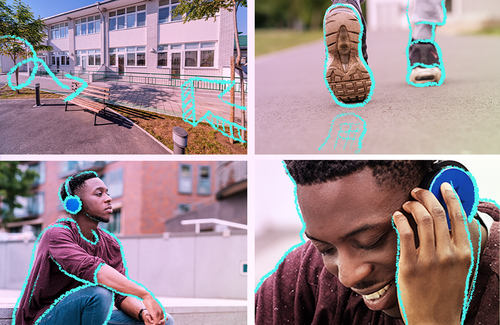Learn how to become a better visual storyteller by analyzing and creating your own video sequences.
Click on the Activities Tab to complete.

After completing this lesson, students will successfully:
Note: This lesson requires basic knowledge of camera operation (DSLR or phone), shot composition, and the simple use of editing software (importing, adding to timeline, exporting). It is recommended that those skills are taught before doing the activities in this lesson.
Analyzing how video shots and scenes are constructed will help students think critically about image construction and creation in the media they consume in their daily lives.
A sequence is a series of shots of an action or scene. A classic action sequence consists of a combination of at least three shots of an action in sequential order.
A document with the details of each shot of the scene or action sequence you plan to record. It contains the Shot Number, Composition/Angle, and Description.
Generally considered to be audio captured from an individual who is on camera, like an interviewee and may also be referred to as a soundbite.
Commonly used as an establishing shot.
Full shot of the person or location. Full body.
Half body, normally from the waist up.
Close Up of the face including neck and shoulders in the shot. Also used for objects.
Shows parts of a person or object in detail.
Shows a person’s back of head and shoulder looking at someone or something.
These can include low/high angles, dollies, POVs (point-of-view), rack focus, etc.
Students recognize the responsibilities and opportunities for positively contributing to their digital communities. (ISTE)
Students communicate clearly and express themselves creatively for a variety of purposes using the platforms, tools, styles, formats and digital media appropriate to their goals. (ISTE)
Journalism
Video Production
Digital Literacy/Citizenship
STEM
Lessons
Beginner
Intermediate
Slides
Online Worksheet
Camera or Mobile Phone
Notebook
2 Hours
Estimated time to complete: 60 Minutes
Use this classroom presentation: IN-CAMERA EDIT: Shooting Sequences SLIDES
WHAT IS A SEQUENCE? A sequence is a series of shots of an action or scene. A classic action sequence consists of a combination of at least three shots of an action in sequential order.
COMMONLY USED SHOTS IN A SEQUENCE:
TYPES OF SEQUENCES (more visual examples found in the presentation)
Example: Capturing an intimate moment - College essay.

Notice that the combination of shots does not follow a specific order. Choosing angles should be intentional and help the story move forward.
WHAT IS A SHOT LIST? A shot list is a document with the details of each shot of the scene or action sequence you plan to record. It contains the Shot Number, Composition/Angle, and Description.
Estimated time to complete: 60 Minutes
IN-CAMERA EDIT: Record an action in sequential order using a camera or phone. The idea of the In-Camera Edit exercise is to learn how to think through and build a sequence around an activity.
You can build a story around your activity or skill if you want, but any VO (voice over) or dialogue has to be done as you shoot it. There is no editing, so you will have to think your story through in advance by creating a shot list. The goal is to tell your story through visual sequences in a minute or two.
** In the field, you may find that some shots work better than others. You may modify your shot list as long as you and your team agree that the change helps move the story forward.